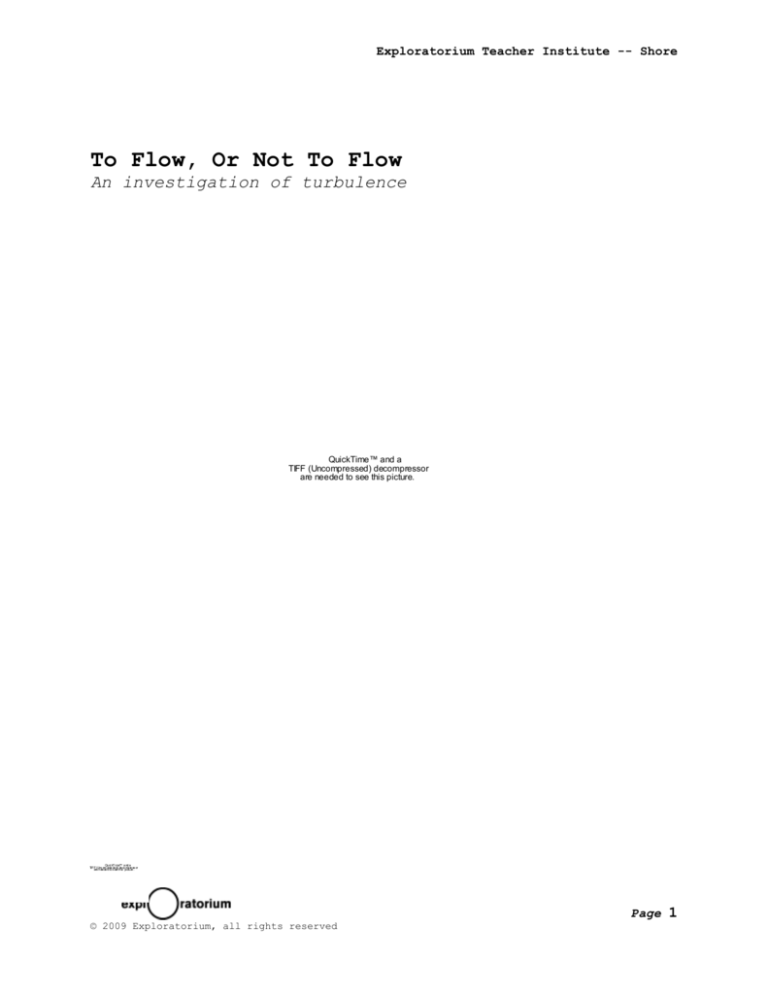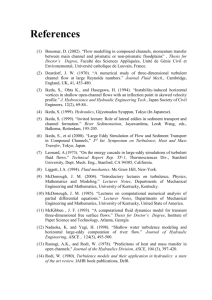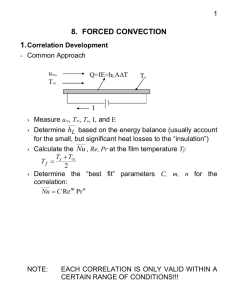
Exploratorium Teacher Institute -- Shore
To Flow, Or Not To Flow
An investigation of turbulence
QuickTime™ and a
TIFF (Uncompressed) decompressor
are needed to see this picture.
Qu ic kTi me™ a nd a
TIFF (Unc om pres se d) de co mp re ss or
are n ee de d to s ee th is pi ctu re .
Page
© 2009 Exploratorium, all rights reserved
1
Exploratorium Teacher Institute -- Shore
This activity was developed with generous funding from a National Institutes of Health Science Education
Partnership Award (NIH-SEPA #1 R25 RR020457-01).
Page
© 2009 Exploratorium, all rights reserved
2
Exploratorium Teacher Institute -- Shore
To Flow, or Not To Flow
How to predict turbulence by finding a fluid’s “Reynold’s Number”
Some Background
When a fluid (like water, oil, or even
air) passes across the surface of an
object, the flow can be either laminar
or turbulent. One way to imagine
fluids is as a stack of thin layers
(like a laminated piece of wood).
Each layer is composed of molecules
QuickTime™ and a
that make up the fluid. In laminar
TIFF (Uncompressed) decompressor
are needed to see this picture.
flow, these individual layers of fluid
don’t mix. Instead, the layers pass
over each other without disturbing the
flow of other layers. In turbulent
flow, the layers mix, flow is no
longer smooth, and whirls of liquid
appear. Examples of laminar and
turbulent flow are shown in the
photograph of Bogie smoking (bad, bad
Bogie!). When smoke first leaves Bogart’s cigarette, the flow of
the smoke is laminar. As the hot smoke rises and accelerates
upward, this flow becomes turbulent.
From Bogie’s cigarette, we can see that turbulence seems to
appear when fluids reach a critical upward speed. Below this
critical speed, flow is laminar; above this speed, flow is
turbulent. Can we predict this critical speed for a given fluid?
Of course we can.
The Reynold’s Number
In 1883, Osborne Reynolds (see picture on the
right) was experimenting with fluid flow and
turbulence. He discovered that when fluids
QuickTime™ and a
TIFF (Uncompressed) decompressor
passed over an object, flow went from laminar
are needed to see this picture.
to turbulence at very specific speeds. The
speed depended on a number of factors,
including the density of the fluid, the speed
of the fluid, the size of the object in the
fluid, and the viscosity of the fluid. A
unit-less number – called the Reynold’s Number (R) in his honor –
predicts if flow around an object will be laminar or turbulent.
R is calculated using the following formula:
Page
© 2009 Exploratorium, all rights reserved
3
Exploratorium Teacher Institute -- Shore
R = (fluid density x object speed x object
length)÷fluid viscosity
If you use this formula and get a number between R = 2000 and R=
4000 , you’ll likely see turbulent flow. Why the range and
ambiguity? Because there are subtler factors that effect the
onset of turbulence, including surface roughness, bubbles and
impurities in the fluid, etc. This is not an exact science
because chaos is involved.
Materials Needed (for each group of 4-5 students)
• an aluminum roasting pan (19in x 11in x 2in).
• shampoo with glycol distearate (we recommend 22 oz Family Size,
Suave “Naturals Tropical Coconut” Shampoo. It smells really
good, too).
• water at room temperature
• a pitcher to hold the water
• a plastic fork
• food coloring
• several 5x7 index cards
• adhesive tape
• a timer
• a meter stick or metric ruler
• a calculator
• scissors
Preparation
•
Pour lukewarm water in the roasting pan until the depth is
about 1/2 inch. At least 15 minutes ahead, pour half the
bottle of shampoo (about 11oz) into the water. Stir gently and
slowly using the fork, making sure that you do not create any
bubbles in the solution (Figure 1). The goal is to break down
the shampoo globs as much as possible. Mix 10 drops of food
coloring in the mixture – red, blue, or green work best. In
this example, we used 8 drops of blue plus 2 drops of red. You
should end up with a solution that looks like Figure 2. Drag
your finger through the liquid and notice the patterns of flow
that you get.
Page
© 2009 Exploratorium, all rights reserved
4
Exploratorium Teacher Institute -- Shore
Figure 1
Figure 2
To Do and Notice
•
Cut three approximately 1 inch by 7 inch rectangles out of
the index cards. Tape the ends of each strip together and
form (1) a circle, (2) a square, and (3) a triangle (see
picture below).
•
Place each shape in the solution
and slowly drag each through the
mixture (see picture below).
Observe the patterns of flow. What
shapes and speeds produce lots of
turbulence (flow with lots of
curls)? What shapes and speeds
produce the least amount of
turbulence?
• Can you find the critical speed
through the fluid in which flow transitions from laminar to
turbulent? When you do, use the meter sticks and timers to
measure distance (d) and time (t). Use v=d/t to calculate the
speed of the shape. This will be the “object speed” in the
Reynold’s number calculation. Use units of cm/sec.
Page
© 2009 Exploratorium, all rights reserved
5
Exploratorium Teacher Institute -- Shore
•
Next, we need an estimate of the fluid density. The density
of water is 1 gm/cm3. Since we mixed a relatively small amount
of shampoo in the water and the shampoo itself is made mostly
of water, we can safely
estimate the density of the
colored fluid as 1gm/cm3 as
well.
•
Next, we need to estimate
the fluid viscosity.
Viscosity is a measure of the
resistance of a fluid to
being deformed by shear
forces or by being stretched
apart. Water has very low
viscosity and is “thin”.
Honey has a higher viscosity
and is “thick”. Table 1 lists some common fluids and their
viscosities. Use this table to estimate the viscosity of the
colored fluid being used in this activity. Units should be in
cgs, or g/cm•s.
•
Last, we need to measure the object length. This is the
diameter for the circle and the length of one of the sides for
the square and triangle. Use cm.
•
We are ready to calculate
formula on the first page,
what value for R you get.
where R is between 200 and
the Reynold’s number (R). Use the
plug in the values above, and see
Were you in the turbulent regime
4000?
Page
© 2009 Exploratorium, all rights reserved
6
Exploratorium Teacher Institute -- Shore
Table 1: Viscosity of some common fluids in mks and cgs units
Fluid
Viscosity (kg/m•s) in
mks
Viscosity (g/cm•s) in
cgs
Acetone
3.06 x 10-4
3.06 x 10-3
Water
8.94 x 10-4
8.94 x 10-3
Mercury
15.26 x 10-4
15.26 x 10-3
Blood
30 - 40 x 10-4
30 – 40 x 10-3
Olive Oil
810 x 10-4
810 x 10-3
Corn Syrup
1.38
13.8
Honey
2 –10
20 – 100
Molasses
5 - 10
50 – 100
Going Further
Here are some Reynold’s Numbers for some familiar objects. Since
turbulence begins when R is between 2000 and 4000, can you tell
which are examples that produced turbulent flow and which are
examples of laminar flow?
Object
Reynold’s Number (R)
Spermatozoa
0.0001
Blood flow in the
brain
100
1000
Blood flow in the
aorta
200,000
Typical pitch in the
major leagues
4,000,000
Person swimming
300,000,000
Blue whale swimming
5,000,000,000
Queen Elizabeth II
Page
© 2009 Exploratorium, all rights reserved
7









